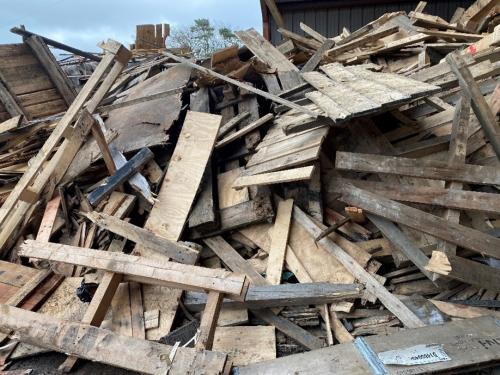In 2018, the UK generated over 222 million tonnes of waste when including household, commercial and industrial waste. This waste was not only made up of typically ‘disposable’ items, but also included items and materials that are reusable, repairable or could have been disassembled to save components for repurposing. Examples include things like household electrical items (an estimated 467,516 tonnes of household waste electrical and electronic equipment (WEEE) were collected in the UK in 2022) and small furniture (an estimated 22 million pieces are thrown away each year in the UK). It is increasingly clear that recycling alone cannot address the problems of high levels of resource use and consumption with high levels of ensuing waste. Accordingly, the concept of the circular economy is gaining more support as an alternative, more holistic approach to tackling waste, and what implications this could have for biodiversity and the climate.
Image: A shipping container turned into a 'reuse shop' where unwanted items are donated and sold for reuse.
According to the Ellen MacArthur Foundation ‘A circular economy is a systemic approach to economic development designed to benefit businesses, society, and the environment. In contrast to the ‘take-make-waste’ linear model, a circular economy is regenerative by design and aims to gradually decouple growth from the consumption of finite resources.’ Or, instead of the ‘take, make and dispose’ model of consumption, a circular economy is one which emphasises reduced use of resources, recovery of components and creating value from waste products.
The circular economy reframes the way products are made and consumed by designing waste out of the production and consumption cycle. In a circular economy, products are reused or repaired, and if this is not possible, the material components are instead repurposed or recycled. By designing out waste, the issue of valuable resources being piled into landfill or polluting precious ecosystems is, in theory, avoided. For the Ellen MacArthur Foundation, a circular economy prioritises the elimination of waste and pollution, circulating products or materials, and regenerating nature. The Circularity Gap Report similarly recognises these social and environmental opportunities associated with the circular economy, but prioritises minimising a country’s material footprint by reducing the extraction and consumption of raw materials across all sectors of the economy.
However, there are over 100 recorded interpretations of the ‘circular economy’ with varying expectations of what a transition to a circular economy involves. While there is still work to be done on establishing a cohesive approach to the circular economy, with such variety in interpretations there is a risk that the circular economy exists solely as an aspirational concept rather than implementable system.
The Scottish Government has recently published its Circular Economy Bill, outlining proposed legislation to facilitate the implementation of a circular economy in Scotland. The proposed legislation includes the introduction of statutory circular economy targets, restrictions to address the ‘disposal of unsold consumer goods’ and enforcing the ‘householder’s duty of care in relation to waste’. When the bill was under consultation, public responses recognised the importance of encouraging behaviour change for individuals as well as a strong emphasis on establishing incentives and regulation to encourage more circular business practices.
Understanding how businesses and people are currently engaging with ‘circularity’ (e.g. adopting business models, practices and behaviours that align with the priorities of resource efficiency, waste minimisation and environmental regeneration) will be essential for informing the transition to a circular economy. With this in mind, our research team at the James Hutton Institute is working on a Scottish Government funded project called ‘Circular Economy: people, behaviours and skills’, which aims to explore the everyday behaviours of individuals and businesses that contribute towards a more circular economy, and the ways in which these behaviours might gain wider participation.
Image: A plastic box filled with assorted motherboards which have been taken from dismantled electronics for reuse.
So far the research has investigated international examples of good practice regarding circular approaches to ‘problem products’ including mattresses, furniture and WEEE, identifying innovations nationally and internationally to address some of the challenges. The project is currently developing a circular behaviours scale for individuals and households, which will be used in a nationwide survey in the year ahead.
Although there are many scales measuring relevant behaviours (e.g. pro-environmental and recycling behaviours), research by the project team revealed a gap when it comes to a measure of specifically ‘circular’ behaviours. Understanding circular behaviours will be necessary for understanding how people engage with the circular economy, and what interventions could be used to encourage widespread adoption by individuals and households.
Researchers are also currently carrying out interviews with businesses and organisations that are incorporating circular economy approaches in their everyday operations, aiming to understand the challenges and opportunities associated with adopting circular business practices. By engaging with businesses and hearing from a range of experiences, the project team will highlight areas where policy could be implemented to support and enable businesses to adopt more circular business practices. We’ll also use agent-based modelling and explore the impact of possible policy interventions on circular behaviours.
The Circular Economy is an expanding area of research, with plenty of existing work on topics such as plastic packaging, fast-fashion, and the insufficiency of recycling as the solution to the problem of waste. While a lot of existing research addresses new technologies, the social and behavioural aspects of the circular economy are less well-researched, yet understanding these will be crucial for informing the effective and lasting transition to a circular economy in Scotland.
Tami Wooldridge & Phoebe Somervail, The James Hutton Institute.
